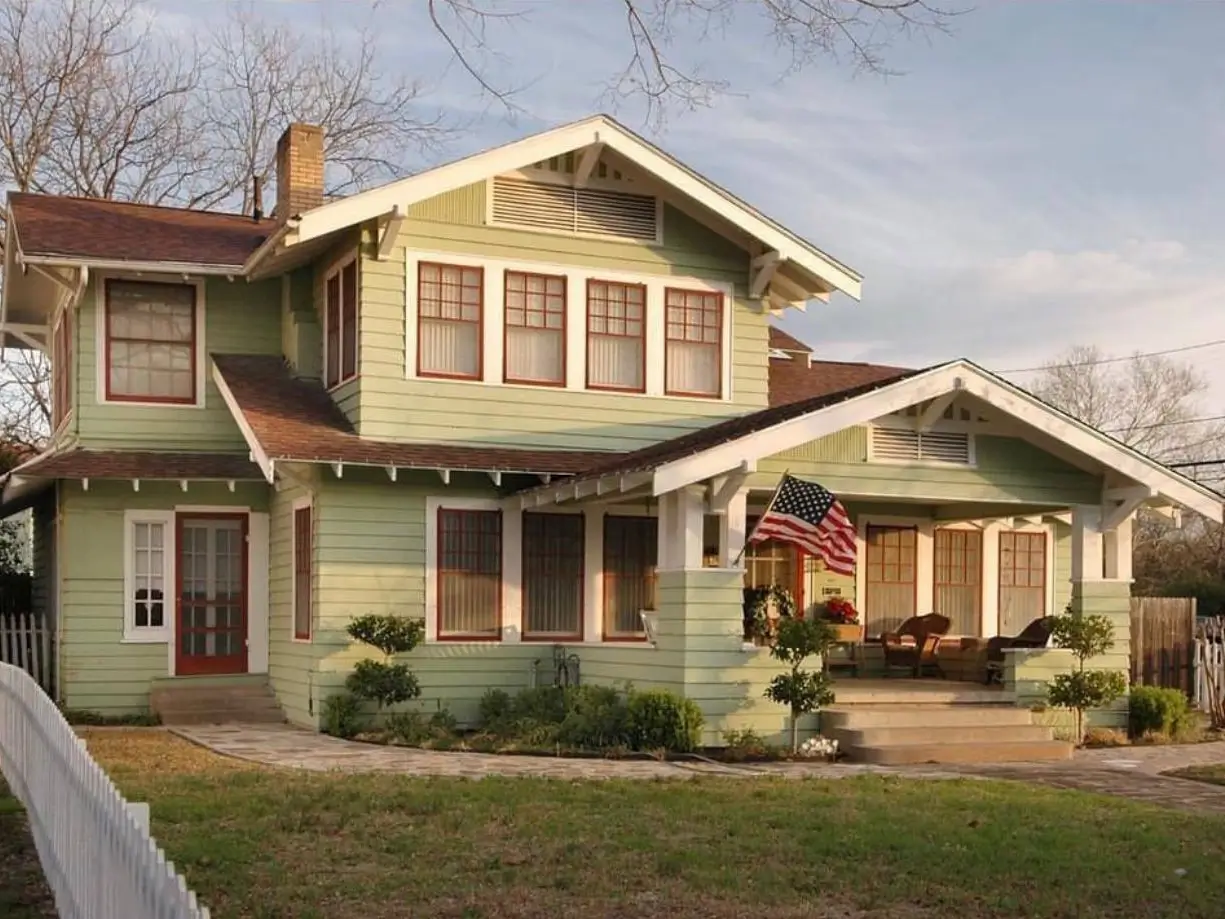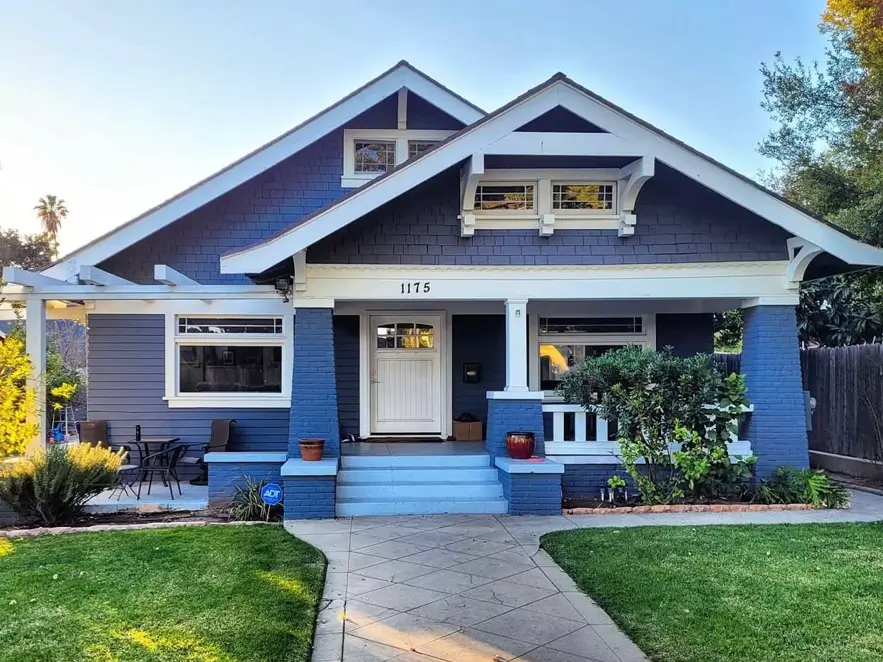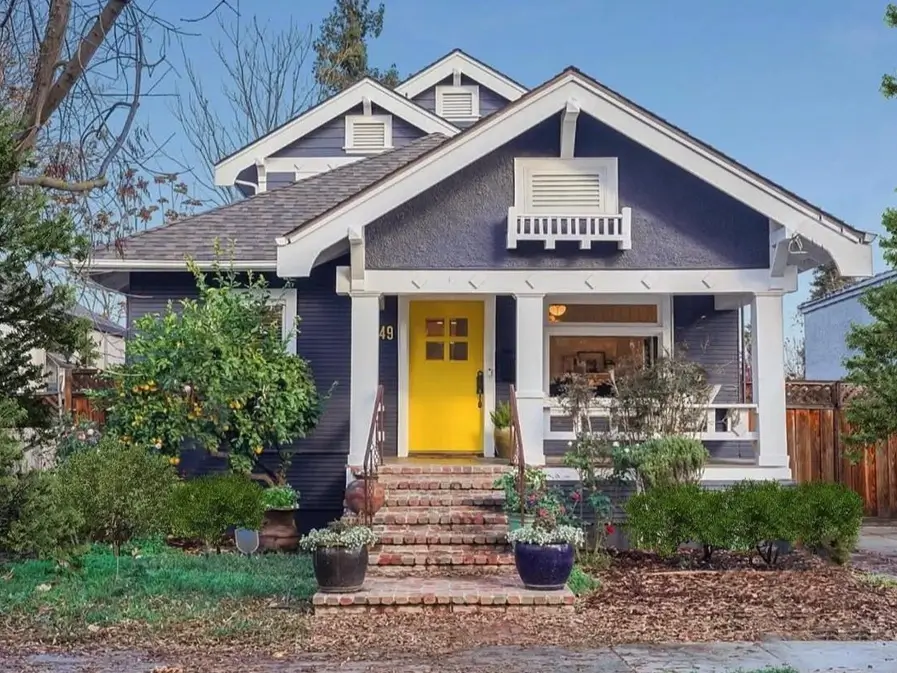Celebrated for its sturdy simplicity and artisanal details, the American craftsman house is a testament to an architectural philosophy born from the Arts and Crafts movement. This enduring style champions honest materials, functional beauty, and a deep respect for handcrafted quality, setting it apart from more ornate designs of its time.
This legacy of quality is why both traditional American craftsman style homes and the updated modern American craftsman house remain so popular. Whether you are restoring a classic or building new, the core principles of comfort and thoughtful design endure. This guide explores the history, defining features, and timeless architectural details that will help you bring this architectural icon’s character to your own home.
Key characteristics of this architectural style include low-slung rooflines, deep overhanging eaves, and welcoming front porches. Internally, the focus on craftsmanship continues with prominent fireplaces and an abundance of natural wood in features like built-in cabinetry, defining the warm aesthetic of American craftsman style homes.

Understanding the Craftsman Philosophy
Emerging in the late 19th and early 20th centuries, the American Craftsman style was a direct response to the ornate and impersonal fussiness of the Victorian era. Influenced by the British Arts and Crafts movement, it rejected mass-produced goods and championed the work of local artisans and visionaries like Gustav Stickley.
The resulting philosophy was simple: a home should be functional, well-made, and integrated with its natural surroundings. This principle, which emphasizes handcrafted quality and harmony with nature, is perfectly embodied in iconic examples like The Gamble House.
Exploring Hallmark Interior Features
The Craftsman philosophy extends beautifully to the interior, creating spaces that are warm, inviting, and highly functional. These are the hallmark features inside many American craftsman style homes.
- Built-in Cabinetry and Nooks: One of the most iconic interior features is the extensive use of built-in furniture. Bookshelves flanking a fireplace, window seats, and dining room buffets were seamlessly integrated into the Arts and Crafts architecture, maximizing space and showcasing fine woodwork.
- The Prominent Fireplace: The fireplace was considered the heart of the home. Craftsman fireplaces are typically large and substantial, often crafted from brick or rustic stone, and serve as a natural gathering spot for the family.
- An Emphasis on Woodwork: The style celebrates the natural beauty of wood. Expect to see thick wood trim around doors and windows, exposed ceiling beams, and wainscoting. Look for artisanal details like stained glass accents in doors or windows, often in simple, geometric patterns.
- Open and Functional Floor Plan: Moving away from the rigid, closed-off rooms of the Victorian era, Craftsman homes often feature a more open floor plan that connects living and dining areas with the kitchen. Living and dining areas flow into one another, creating a functional, family-centric space that enhances the feeling of natural light and connection.
Inspiring Exterior Design Ideas
The exterior of an American craftsman house is where its character is most immediately expressed. These renovation ideas and design inspirations showcase the style’s defining features.
Core Architectural Elements
These are the foundational components that create the classic Craftsman silhouette.
1. Mix Natural Materials

A richly textured exterior is a hallmark of American craftsman style homes. Combining wood shingles, painted siding, and a sturdy stone foundation creates visual depth and harmony. This approach highlights the home’s solid construction and connection to its natural surroundings.
2. Design an Expansive Porch

Central to the philosophy of the style is the inviting front porch. Often supported by thick, tapered columns, this outdoor space serves as a natural extension of the interior, creating a welcoming transition for guests of your American craftsman house.
3. Feature Tapered Columns

Signature columns are a defining characteristic of this architectural style. Typically square and wider at the base, these supports often rest on stone or brick piers, visually anchoring the home. In my experience, ensuring the scale of the columns matches the home’s overall mass is crucial for an authentic look.
4. Opt for Low-Pitched Roofs

Characteristically, an American craftsman house features a low-pitched roof with wide, overhanging eaves. This design element creates a deliberately grounded silhouette, emphasizing the home’s connection to the earth.
5. Anchor With Natural Stone

Using rugged, natural stone for porch piers provides a powerful visual anchor, making the home feel deeply connected to the land. This choice of material adds texture, permanence, and a sense of rustic elegance to the design.
6. Build a Prominent Chimney

A substantial chimney, often built from brick or stone, is a quintessential element that anchors the home. It speaks to the warmth and comfort of the hearth within, reinforcing the craftsman ideal of the house as a welcoming sanctuary.
Signature Structural & Artisanal Details
These are the handcrafted features that signal quality and celebrate the home’s construction.
7. Expose Structural Details

A hallmark of the Craftsman ethos is revealing the beauty in a home’s construction. Exposed rafter tails beneath the deep roof eaves are a classic example, adding a rhythmic pattern that celebrates the structure’s hand-built character.
8. Add Artisanal Wood Accents

Thoughtfully chosen details like custom wood shutters enhance a home’s character. These elements add texture and an artisanal touch, reinforcing the connection to natural materials and handcrafted quality that is a core tenet of the style.
9. Choose Multi-Pane Windows

Windows with multiple panes, often grouped together, are a signature of the style. The divided lights create a charming, structured look that complements the sturdy and honest architecture of an American craftsman house.
10. Integrate Decorative Knee Braces

Often found tucked beneath the gables, decorative knee braces are a quintessential detail. These triangular supports provide both visual strength and an artisanal touch, expressing the home’s sturdy construction.
11. Select a Statement Door

The front door on an American craftsman house is more than just an entry; it’s a welcoming focal point. Traditionally made of solid wood, it signals the home’s quality and artisanal spirit right from the curb.
12. Use Heavy Timber Framing

Drawing inspiration from rustic lodges, many modern American craftsman house designs feature heavy timber framing. These substantial beams and posts create a powerful sense of shelter and permanence.
13. Showcase Gable Trusses

For a truly authentic touch, showcase decorative gable trusses. This structural detail elevates the home’s design, adding a layer of handcrafted artistry and celebrating the construction itself.
14. Add Half-Timbering Details

To evoke a picturesque feel, consider incorporating half-timbering in the gables. This decorative treatment pays homage to the English Tudor and medieval influences that inspired the Arts and Crafts movement.
Key Architectural Features
These larger design choices shape the overall form and function of American craftsman style homes.
15. Incorporate Gabled Dormers

Gabled dormers provide both aesthetic appeal and practicality. These structures break up the expanse of a low-pitched roof, adding visual interest while allowing natural light to fill the upper stories.
16. Add a Shed Dormer

Distinctive shed dormers are a common sight on the craftsman bungalow. This design element maximizes light and headroom in the upper story, turning attic space into bright, livable areas.
17. Include an Upper Balcony

Expanding on the classic porch, an upper-level balcony offers a private outdoor retreat and enhances the home’s connection to its environment, providing an elevated vantage point to enjoy the landscape.
18. Embrace Symmetrical Design

Achieving balance through a symmetrical facade imparts a sense of harmony. This intentional design choice reinforces the home’s stable and grounded character, a hallmark of American craftsman style homes.
19. Add a Bay Window

A projecting bay window is a charming feature that adds dimension to the facade while flooding the interior with natural light and creating a perfect sunlit nook for reading or relaxing.
20. Design a Wraparound Porch

A wraparound porch is a generous extension of the home’s living space, offering multiple areas for relaxation and embodying the gracious, welcoming spirit of the American craftsman house.
Color, Finish & Modern Touches
These elements complete the aesthetic and adapt the style for contemporary living, especially in a modern American craftsman house.
21. Use a Moody Palette

Pairing deep, moody siding with crisp white trim creates a striking contrast. This approach lends a modern sensibility while honoring the traditional silhouette of a modern American craftsman house.
22. Select an Earthy Palette

Choosing an earth-toned color palette of deep greens, warm browns, and other organic hues helps the home blend seamlessly with its landscape, reinforcing its solid, grounded presence.
23. Pair Stucco and Stone

Stucco, often paired with a stone or brick foundation, provides a textured, earthy finish that grounds the structure visually and emphasizes its connection to natural materials.
24. Add Period-Style Lighting

Exterior lighting is a key finishing touch. Period-inspired fixtures, such as lantern-style sconces, cast a warm, inviting glow and create a welcoming ambiance after dusk.
25. Create a High-Contrast Look

For a bold, contemporary statement, pair dark vertical siding with the natural warmth of timber beams. This high-contrast approach dramatically highlights the home’s structural artistry.
26. Combine Stone and Siding

Combine a rugged stone facade on the lower level with crisp vertical siding above. This pairing adds textural contrast and visual weight, grounding the home while the vertical lines draw the eye upward.
27. Integrate the Garage Door

In a modern American craftsman house, the garage door is an integral part of the facade. Selecting a door that echoes the home’s materials and colors makes it a complementary architectural feature.
28. Use Contrasting Trim

Dark window frames set against light siding create a crisp, graphic effect on a modern home, sharply defining the openings and adding depth.
29. Design Complementary Landscaping

Thoughtful landscaping is a crucial extension of the home that significantly boosts its curb appeal. Sweeping curves in walkways and garden beds soften the strong lines of the architecture. A common mistake to avoid is planting rigid, formal hedges that clash with the Craftsman’s natural aesthetic.
Frequently Asked Questions
What truly defines a Craftsman style house?
The most defining features of American craftsman style homes include a low-pitched roof with wide, overhanging eaves, exposed rafters, a large front porch with tapered columns, and multi-pane windows. The style emphasizes natural materials and handcrafted details like built-in cabinetry indoors.
How is a modern Craftsman different from a traditional one?
A modern American craftsman house honors the classic form but often incorporates contemporary elements like open-concept interiors, larger windows, and a more neutral or high-contrast color palette. While it maintains key craftsman features, the execution is typically cleaner and less ornate.
Is there a difference between a Craftsman and a Bungalow?
“Craftsman” refers to the architectural style itself, which can be applied to various house sizes. “B bungalow” typically describes a smaller, more modest house, often one to one-and-a-half stories. Many bungalows are built in the American Craftsman style, which is why the terms are so frequently linked.
What are the best exterior colors for an American craftsman house?
Traditional exterior color schemes for an American craftsman house favor an earth-toned palette that helps them blend with nature, such as olive greens, muted browns, and deep reds. Modern interpretations may use brighter whites, dramatic charcoals, or deep blues, often paired with crisp white or black trim for a bolder contrast.
Last Updated: October 3, 2025 6:50 AM



